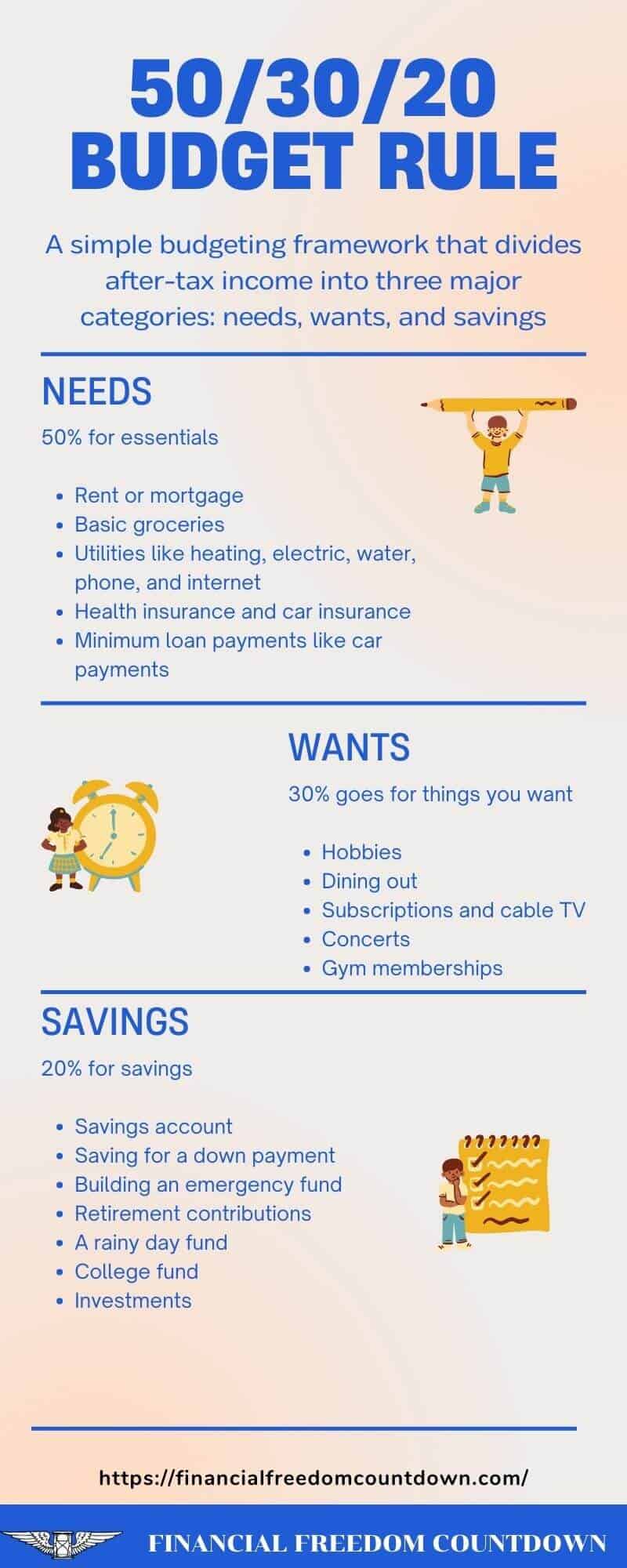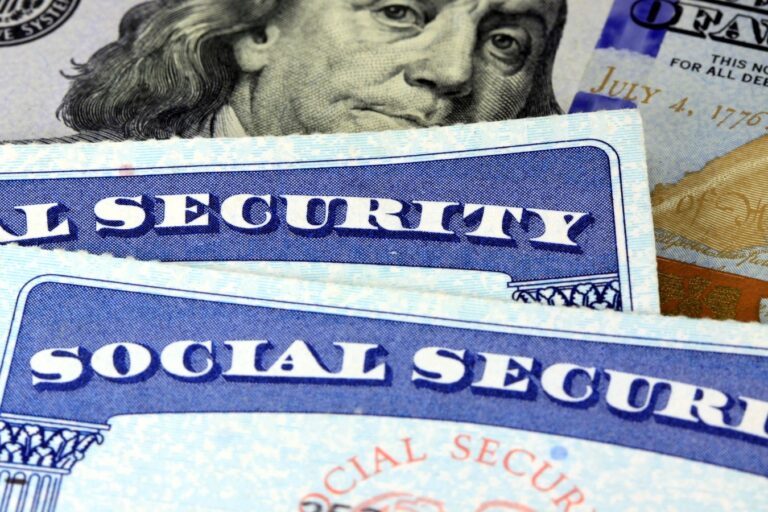50/30/20 Rule: A Simple Budgeting Technique

A budget is a good idea for every household. Every month we look at our bank account and wonder where our entire paycheck went. Writing out where every dime of our paycheck goes each month can give us a handle on our spending and take control of our personal finance and expenses.
If we can write out a realistic budget and stick to it, we might find ways to cut back and have additional money each month. Budgeting is an excellent way to see exactly where our paycheck goes each month. The 50/30/20 budget rule is a budgeting rule that can help you stick to a budget and be able to save more each month. Some people refer to this as the 50/20/30 rule, but it is the same.
What Is the 50/30/20 Rule?
The 50/30/20 rule is a simple budgeting framework that divides after-tax income into three major categories; 50% for essentials, 20% for savings and debt payments, and 30% for everything else, sometimes called your needs, wants, and savings.
Elizabeth Warren and her daughter popularized the 50/30/20 rule when they wrote about this simple budgeting method in their book.
Paychecks are then divided as follows:
- 50% for essentials include the mortgage payment, rent, other housing bills, groceries, etc.
- 20% for savings accounts, credit card payments, loan payments, and retirement contributions.
- 30% goes for things you want like nonessential items, including clothing, subscriptions, restaurants, etc.
Following this rule has helped many be able to save money at the end of each month. But this is a rule of thumb guideline, and circumstances will differ for each person. Depending on where a person lives can make it harder or easier to follow the 50/30/20 rule. If they live in a city with unusually high rent and where living is expensive, like San Francisco or New York, budgeting is harder to accomplish.
But even closely following the rule will help everyone see precisely where their paycheck is going each month. Because you can see where the money goes, it is easier to find ways to save money.
Where Did the 50/30/20 Rule Come From?
The 50/30/20 budgeting rule was popularized by Senator Elizabeth Warren when she was a law professor at Harvard. She coined the phrase 50/20/30 when she and her daughter, Amelia Warren Tyagi, wrote a book titled “All Your Worth: The Ultimate Lifetime Money Plan.”
The book was published in 2005 as a rule of thumb to help working-class families better budget their steady paycheck and spending. The rule is designed to help everyone prepare for their future.
Why Is a 50/30/20 Budget Necessary?
As a rule of thumb, the guideline is like any other budget. If followed, it can allow families to see where their paychecks are going and, in a way, force them not to spend too much on unnecessary items.
One concern for many working-class Americans is whether or not social security will be enough money to live on after retiring. As everything becomes more expensive, it is looking more and more unlikely that social security will be enough to cover living expenses.
Whether someone decides to follow the 50/30/20 budgeting rule or a variation of this rule, a budget is helpful for the following reasons.
A budget keeps you from spending money you don’t have. If a budget is strictly followed, no one should have to spend cash they don’t have. Spending what you don’t have is the most common way people get into credit card debt. And debt from credit cards is one sure way to keep you from reaching your financial goals.
A budget keeps a person on track to reach their financial goals. That goal might be paying off debt, saving for a down payment, vacation, or any other financial goal. A budget helps everyone stay the course.
Budgets create responsible use of money, and using money responsibly will turn into larger savings accounts and retirement funds. Since savings are already built into the 50/30/20 budget plan, you will automatically put money into one or more savings accounts and investment accounts. Savings goals can include an emergency fund, college funds, and retirement accounts.
A budget helps to identify bad spending habits. When you understand where you are wasting money, you can stop those bad spending habits and put that money into the 50/30/20 budgeting method.
Budgets help everyone find places to cut back. Does anyone need so many shoes or 500-channel cable subscriptions? Those are unnecessary items that could go into bank accounts or necessities. Just think about how much could be accumulated if not for all the unnecessary purchases.
Most companies drain our money by asking us to sign up for subscription services. We often pay for several subscription services and don’t even use them.
Trim is an excellent service that looks at all your current subscriptions and saves money by eliminating unnecessary money leeches. Also, instead of paying full price, see if Trim can do the work negotiating your cable, phone, and internet bills lower.
Following a budget will also give everyone peace of mind. When you know where your money is spent, you can rest easier. Peace of mind allows you to relax and take control of your savings goals. Sticking to a budget could help you keep more from your take-home pay.
How To Use the 50/30/20 Rule Budget?
Using the 50/30/20 rule, calculate the monthly income or take-home pay. Look at the paycheck and see how much ends up in your bank account each payday. If you’re paid more than once per month, it might be easier to add it up and calculate for each month.
If the paycheck automatically deducts payments like pension funds, retirement funds, or health insurance, add those amounts to your take-home pay.
If you work for yourself, the after-tax income is what you earn each month, minus monthly expenses for business and money set aside for tax payments.
The next step is to figure out how much money to put into each category. There are only three major categories we need to figure out. Bank or credit card statements will show where you spent the money.
If you have several bank accounts or credit cards, you can use Personal Capital, free software which combines your cash flow, credit cards, bills, and bank account transactions in one place and makes it easy to manage. It automatically updates and classifies your financial data to know where you’re at financially.
Unlike other budgeting apps, Personal Capital doesn’t need you to do the tedious task of setting up a budget. After you link all your accounts together, it looks at your current spending and creates a budget for your lifestyle. You can then modify it as needed to suit the 50 30 20 rule. You can read my Personal Capital Review on how I use the various components and set up your free account.
Writing down your expenditures during the month will help you go through this process. Now split the expenses into one of the following three categories. The 50% category is for necessities such as:
- Rent or mortgage
- Basic groceries
- Utilities like heating, electric, water, phone, and internet
- Health insurance and car insurance
- Minimum loan payments like car payments can go in this category instead of the 20% category
- Other necessary expenses
The 30% category is for the things you want. It is not always easy to differentiate between wants and needs. A rule of thumb is wants are extras that are not essential to living or working. Some examples include:
- Hobbies
- Dining out
- Subscriptions and cable TV
- Concerts
- Gym memberships
The 20% category is for savings and debt repayment. Every time you pay down credit card debt or other debt payments that carry interest, you save yourself money. If you’re paying 16% interest on a credit card, by paying it down, you are earning that 16% by not having to pay it in the future. Because of this, you should pay off credit cards with the highest interest rate first.
Since credit card debt is a very high-interest rate, it is best to pay it down as soon as possible. If you have been paying higher interest on credit cards, check out individual loan rates from around ten vetted lenders in 2 minutes on Credible to pay off your credit card debt.
Use the Personal Loan only to eliminate your higher interest rate debt and not take on additional debt.
The 20% category should include:
- Savings account
- Saving for a down payment
- Building an emergency fund
- Retirement contributions and other retirement savings so we have enough retirement income when we retire
- A rainy day fund
- College fund
Now you can see exactly how much needs to go into each category. Don’t worry if you don’t have enough income for a category since it can be tweaked for your after-tax income and wants and needs.

An Example of the 50/30/20 Rule of Thumb
Calculate the monthly after-tax income or your take-home pay. For example, each month, you are paid $4,000. That is your after-tax income. If money is deducted from your take-home pay for health insurance, 401(k), a pension fund, or other retirement plans, add that amount to your after-tax income.
Let’s say you put in $500 per month to the retirement plan; then, your take-home pay is now $4,500 each month. Now we will calculate the amount of take-home pay that goes into each category according to the 50/30/20 rule. For the 50% essentials category, we multiply $4,500 by 0.5 and get $2,250.
For the 30% things you want category, we multiply $4,500 by 0.3, which equals $1,350. And for the savings and debt payment category, we multiply $4,500 by 0.2 for $900.
You already have accounted for the $500 that is put into a retirement fund, so the remaining $400 out of the remaining $900 is to lower credit card debt and other debts. According to the 50/30/20 rule of thumb, this is how a take-home pay of $4,500 would break down:
- Necessities: $2,250 or $4,500 x 0.5
- Wants: $1,350 or $4,500 x 0.3
- Goals like savings goals and debt repayment: $900 or $4,500 x 0.2 minus the $500 already saved in a retirement fund
Please do not neglect the goals like 401(k) contributions because they will help you retire early.
Final Thoughts On the 50/30/20 Rule
The 50/30/20 rule is a monthly budgeting tool that divides your monthly income into three categories, needs, wants, and savings. The budget plan can help anyone understand where their weekly paycheck goes and help to control bad spending habits.
A monthly budget is the best way to handle your personal finance and make your financial lives more manageable. You can also use a budget for our financial protection by keeping us from getting into debt, which can happen before we know it.
Your monthly income only goes so far, and a budget helps you put the finances where it needs to go for necessary expenses, paying off existing debt, and could help you save more for other savings goals. If there is additional money after the categories are taken care of, extra payments can go towards paying off debt quicker or saving money.
You still have to track your spending to make sure you’re on track every month. If you set up the budget and then forget to track your spending, you won’t know if you’re on track every month.
None of us need a financial expert to tell us that the high cost of living makes it harder to meet a budget. But by seeing a budgeting plan in front of us, we might be able to stick to a budgeting plan easier.
Don’t be fooled by the simplicity of the 50/30/20 budget, assuming you can’t use it to build generational wealth. The savings can also include your goals to invest in stocks or real estate investing.
50/30/20 budget is a plan we can do without the help of financial experts or financial products. Instead of buying expensive financial planning industry software, we can use any spreadsheet program or paper and pen to make the 50/30/20 rule work.
50/30/20 Rule Frequently Asked Questions
As with most personal financial plans, there will always be questions. The better you understand your monthly budget, the easier it will be to follow it.
How Does Tithing Affect the 50/30/20 Rule?
The 50 30 20 rule of thumb is flexible. It is up to the individual to decide how they spend their earnings and how to classify them. With tithing or other religious donations, it is up to you to decide if this goes into a goal or want, or even a need category.
Does the 50/30/20 Rule include a 401(k) Plan?
Yes, the 50/30/20 rule includes 401(k) under the savings category. As explained in the example above, you would include the amount you put into a retirement fund like a 401(k) or pension plan in the take-home pay. And then subtract this amount from your 20% savings and debt repayment category since it has already been spent for retirement.
What Should I Do if I Don’t Have Enough Monthly After-Tax Income?
You are not alone in facing this situation, and it is a common question. With today’s high cost of rent and rising inflation, 50% isn’t enough for the necessity category. In this case, it would be best to take some from the 30% “wants” category and use it for the necessity category.
That leaves less income for the things we might want, like subscriptions or dining out, but the necessities need to come first. Find some expenses you can cut from the 30% “wants” category for the time being.
The next step should be improving your human capital to increase your income gradually.
Of course, most jobs are not conducive to increasing salary no matter how great you are at work. A better option is to then work on side gigs. It could be as involved as
investing in real estate with little or no money down, using a partner to fix and flip houses, or wholesaling real estate.
If you want a more straightforward way to increase your income with a business, you could start a website.
Your website could be related to your day job. Or you could create one talking about your hobbies. Given the digital economy, no matter which path you pick, more and more of our world will be moving online. Automated tools make it easy to start a website in 10 minutes with zero computer programing skills. Here is my Bluehost affiliate link to get started with a monthly cost of only $2.95.
All the above options are active income and need your time and energy. Another opportunity to get more money would be to consider passive income idea
Why Does the 50/30/20 Rule of Thumb Generally Work for Monthly Income?
It works because it is a structured budget with no guesswork each payday. It lets you see exactly where your paycheck is going and helps cut down on wasteful spending.
A budget like this shows you the state of your financial health at any given moment. Budgets seem complicated, but this basic rule is not complex, and no one should need a certified financial planner to get a budget like this to work.
Is the 50/30/20 Rule the Ultimate Lifetime Money Plan?
As with any rule of thumb, they are not set in stone. But by adhering to the guidelines of the 50/30/20 rule, most people will be able to limit wasteful spending and set achievable financial goals.
There are various similar budgeting methods. The 80/20 rule states that a person takes 20% of their monthly income and puts that into a bank account. The other 80% will go towards all other monetary needs, including health care. The 20% rule forces a person to save or invest 20% of their take-home income.
Some prefer to use the 70/20/10 rule. For this rule, you divide your monthly after-tax income categories by 70% for all living expenses, 20% for debt payments, and the remaining 10% for savings. Whatever budgeting rule a person decides to follow is up to their individual circumstances.

John Dealbreuin came from a third world country to the US with only $1,000 not knowing anyone; guided by an immigrant dream. In 12 years, he achieved his retirement number.
He started Financial Freedom Countdown to help everyone think differently about their financial challenges and live their best lives. John resides in the San Francisco Bay Area enjoying nature trails and weight training.
Here are his recommended tools
Personal Capital: This is a free tool John uses to track his net worth on a regular basis and as a retirement planner. It also alerts him wrt hidden fees and has a budget tracker included.
Platforms like Yieldstreet provide investment options in art, legal, real estate, structured notes, venture capital, etc. They also have fixed-income portfolios spread across multiple asset classes with a single investment with low minimums of $10,000.





I’d love it for years and I still advocate for it. For me, 50/20/30 eliminated the guilt of “I should be saving EVERYTHING” and gave me a little spending money. It was a simple guideline. I am saving more now, but that rule was my start into budgeting.
Yes, the simplicity of dividing your money into 3 buckets and spending guilt-free is great. Thank you for sharing your experience.